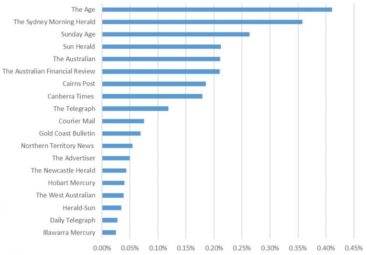Australian National University researcher Anthony Swan explores how Australians’ perceptions of Papua New Guinea are influenced by the Australian media.

ANU Researcher, Anthony Swan
‘Fewer and fewer Australians have any real knowledge of this fascinating country to Australia’s north, which we were responsible for bringing to nationhood,’ wrote long-serving ABC Pacific Correspondent, Sean Dorney.
‘This lack of understanding affects our dealings. The Australian media generally ignores PNG.’
Last year, PNG’s High Commissioner to Australia, Charles Lepani, was also critical of the level of Australian engagement and understanding of PNG issues: ‘Australia remains substantially ignorant of Papua New Guinea.
‘There were around 2 million Australian newspaper articles published over the last five years, of which 2660 were about PNG.’
‘You cannot dig any deeper than the ongoing Manus issue to see the vitriol and vilification borne out of ignorance by Australians of Papua New Guineans and our country.’
Newspaper coverage
To what extent does the Australian media focus on PNG, and, when it does, what issues are focused on? Are there differences in the way PNG stories are reported across media outlets?
In terms of overall PNG focus, Factiva search results indicate that there were around 2 million Australian newspaper articles published over the last five years, of which 2660 were about PNG in some form.
This represents an overall share of 0.13 per cent or slightly more than one article per 1000 published. Looking beyond newspaper articles, including ABC (web-based) articles in the analysis does improve the PNG share to 0.21 per cent, reflecting the ABC’s relative focus on our region.
‘The PNG share was only almost exactly the same as the share of articles about Kim Kardashian.’
If anything this number is probably higher than I expected. In comparison, the share of Australian newspaper articles over the last five years focused on Indonesia, New Zealand, and Fiji was 0.70 per cent, 0.43 per cent and 0.07 per cent, respectively.
The PNG share was only almost exactly the same as the share of articles about Kim Kardashian.
Topics
My analysis of Australian newspaper articles on PNG indicated that around 30 per cent of articles were related in some form to Australia’s offshore detention centre in PNG. About 15 per cent each was dedicated to the prime ministerial dispute and to business reporting related to LNG/Oil Search. Around 10 per cent of reporting was on crime and violence in PNG.
That doesn’t leave much room for reporting on issues that might help Australians gain any deep insights into PNG culture or development (which together account for about 20 per cent of articles).
‘News Corp papers were also estimated to publish more frequently on the topic of economic development relative to the Fairfax group.’
An average of around 20-25 per cent of all News Corp articles related to PNG papers was estimated to be devoted to the dispute about the Prime Minister dispute as compared with an estimate of around 7-11 per cent for Fairfax.
News Corp papers were also estimated to publish more frequently on the topic of economic development when compared with the Fairfax group, although this ratio is reversed for the asylum seekers topic.
There is no statistical difference in the prevalence of reporting on the crime/violence topic across these newspaper groups.
Variable reporting
 While it is certainly debatable, I wouldn’t say that Australian newsprint media ignores PNG.
While it is certainly debatable, I wouldn’t say that Australian newsprint media ignores PNG.
However, the analysis indicates that Australian newspaper reporting on PNG is variable, both in terms of its extent, the issues that are focused on, and the way those issues are reported.
Nonetheless, it seems that the Australian media will tend to focus on dysfunction in PNG, whether it is of PNG’s own-making (for example, the PM dispute and crime/violence) or not (for example, the Manus detention centre).
Perhaps expecting the media to help Australians build any deep knowledge of PNG is putting the cart before the horse. It’s the people-to-people links between Australians and Papua New Guineans that are missing. Improve that, and Australian media reporting on PNG will improve.
Anthony Swan is a Research Fellow at the Development Policy Centre at the Australian National University. This is an edited version of his latest post, which is the second in a two-part series analysing coverage of PNG in Australian media; read the first part here.









Speak Your Mind